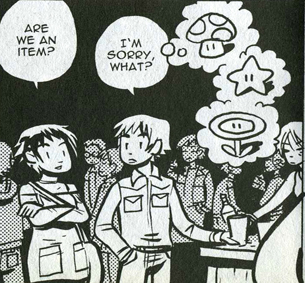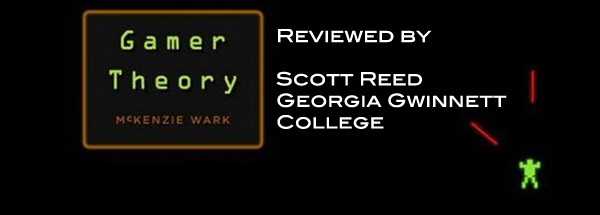
One of the most challenging aspects of Gamer Theory is its engagement with space, particularly the term “gamespace,” whose meaning is explored and nuanced throughout the book. Rather than being a term whose meaning coincides with, say, “virtual world,” gamespace is a more far-reaching concept, encompassing not only the space of video games themselves, but the spaces in which those games are played, discussed, produced, and negotiated.
Wark leads off Gamer Theory with a chapter referencing one of the most oft-cited spatial metaphors in the history of Western thought: Plato's Cave. Wark partially takes the metaphor of The Cave at face value, initiating the book's over-arching concern over the dominance and interpolative power of what he (riffing from Dwight Eisenhower) calls the “military entertainment complex.” The power of gamespace is that it makes the world seem like “a matrix of endlessly varying games… all reducible to the same principles” (15). In other words, even if one were to realize the Platonic dream and free one's self from The Cave, one would only end up in another Cave, another game. Instead: “The gamer arrives at the beginning of a reflective life, a gamer theory, by stepping out of The Cave – and returning to it” (19). The mastery of any one topic – any one space of ideas – is insufficient to grasp the shape of gamespace in all its complexity, and it's that project with which Gamer Theory is chiefly concerned. Wark's move outside The Cave is to introduce a challenging trio of terms: topic, topography, and topology, whose meanings not only paint a history of digital media but also demonstrate how games themselves can be reconceptualized.
A topographical understanding of space is of a space already mapped. Topographical thinking is much less a project of getting to know a particular place than one of looking for connections between places. In “America (on Civilization III),” Wark explores the topographical effects of some important “lines” on the development of America: the transportation lines provided by railroad and the communication lines provided by telegraph. With shades of the media theories of Marshall McLuhan and Friedrich Kittler, these technological “lines” produce a subject characterized by an attitude towards space, by a will to colonize and map. Wark cites the mythos of America's Western expansion as a crucial cultural analogue, where frontier heroes extend America's geographic and ideological topography while becoming enshrined in the local history (54). That history is just another level of topography: a more cognitive kind of map that locates us in particular places. Topography represents, ultimately, “not only the means of producing spatial and social differentiation but of overcoming it” through narratives of mastery (105).
 When Wark writes that gamespace conditions its subjects to belong to (real) spaces as a gamer to a game (15), this quick compression of terms could encourage gamer theorists to see their subject matter as recapitulating a purely colonial sensibility, one based on a domination of mastery of space. Without ever dispelling that possibility per se, Wark does move beyond the problem of topographical thinking to introduce a disruptive and altogether frustrating third term: topology. Wark, in his fashion, offers no preliminary definition of the term before diving into its usage, leaving the potentially hapless reader to assemble a definition somewhat paratactically: appropriate enough for a term so laden with poststructural implications. While topology figures prominently in some of Jacques Lacan's later work, its more immediate analogue can be found in Deleuze's notion of “the fold” – a complex way of understanding how a monad (a singular entity – like “space”) consists of a multiplicity of complex and varied “folds.” If topography makes sense of multiplicity by mapping it and drawing lines between points to link spaces (and histories) together, topology does away with point-to-point connections in favor of broad multiplicities. With the rise of the digital, “history and geography are subsumed within a topology, which end toward a continuous field of equivalent and exchangeable values, instantly communicable everywhere” (56). If topography is a grid made of lines, topology is altogether more slippery, a symptom of a world both more playful and more frustratingly un-mappable.
When Wark writes that gamespace conditions its subjects to belong to (real) spaces as a gamer to a game (15), this quick compression of terms could encourage gamer theorists to see their subject matter as recapitulating a purely colonial sensibility, one based on a domination of mastery of space. Without ever dispelling that possibility per se, Wark does move beyond the problem of topographical thinking to introduce a disruptive and altogether frustrating third term: topology. Wark, in his fashion, offers no preliminary definition of the term before diving into its usage, leaving the potentially hapless reader to assemble a definition somewhat paratactically: appropriate enough for a term so laden with poststructural implications. While topology figures prominently in some of Jacques Lacan's later work, its more immediate analogue can be found in Deleuze's notion of “the fold” – a complex way of understanding how a monad (a singular entity – like “space”) consists of a multiplicity of complex and varied “folds.” If topography makes sense of multiplicity by mapping it and drawing lines between points to link spaces (and histories) together, topology does away with point-to-point connections in favor of broad multiplicities. With the rise of the digital, “history and geography are subsumed within a topology, which end toward a continuous field of equivalent and exchangeable values, instantly communicable everywhere” (56). If topography is a grid made of lines, topology is altogether more slippery, a symptom of a world both more playful and more frustratingly un-mappable.
 The activity of gaming is both a symptom of and complicit in the construction of the world as a topological space. “Open-world” games like Grand Theft Auto: Vice City show how games create, though their dense layers of procedures, what Wark calls: “[an] atopian dream of gamespace, where the lines are so dense, the digital so omnipresent, that any and every object and subject is in play, and all of space is a gamespace” (108). Gaming's ubiquity condenses and solidifies that dream by converting our experience of space into that of a game. In topological gamespace, we're far less likely to see tidy divisions between our spaces of work and our spaces of play: rather than being divided by a line, they are more like planes folded around and into each other. Borrowing language from Henri Lefebvre, the “heterotopias” of modern life have all collapsed onto themselves. This means both a loss of useful distinctions (when work and play coincide, the latter is too easily co-opted by the former, Wark warns), but also a set of interesting possibilities: for using games as a way of rethinking both work and play at the same time.
The activity of gaming is both a symptom of and complicit in the construction of the world as a topological space. “Open-world” games like Grand Theft Auto: Vice City show how games create, though their dense layers of procedures, what Wark calls: “[an] atopian dream of gamespace, where the lines are so dense, the digital so omnipresent, that any and every object and subject is in play, and all of space is a gamespace” (108). Gaming's ubiquity condenses and solidifies that dream by converting our experience of space into that of a game. In topological gamespace, we're far less likely to see tidy divisions between our spaces of work and our spaces of play: rather than being divided by a line, they are more like planes folded around and into each other. Borrowing language from Henri Lefebvre, the “heterotopias” of modern life have all collapsed onto themselves. This means both a loss of useful distinctions (when work and play coincide, the latter is too easily co-opted by the former, Wark warns), but also a set of interesting possibilities: for using games as a way of rethinking both work and play at the same time.
Games are a symptom of this folding, in that they show how thoroughly work and play have been folded into each other, and yet they can also serve as our interfaces for rethinking and reorganizing our spaces. In the hands of the gamer theorist, each game becomes an interface for arresting the confusing multiplicity of our situation by generating “allegorithms” that link the space of the game to the spaces of the “real” world: doing gamer theory means jumping across the folds between gamer, game, and world. Recognizing our spaces (our rhetorical situations) as being so variegated and complex is a first step towards “play[ing] within the game, but against gamespace. Be[ing] ludic, but also lucid” (19).
Left somewhat unaddressed – or rather intermittently addressed – is the “real world” itself. While Gamer Theory opens and closes with challenging references to the globalized scene of labor, Wark's rhetoric pays little sustained attention to the world outside The Cave – to the grit and grime of the real world that our digital topology often “folds” out of view (so to speak). Those wishing to appropriate Gamer Theory for doing serious work in the classroom will no doubt find those rhetorical lapses frustrating. Ultimately, the notion that the real world is only knowable through the virtual (through the game), but that creative processes help us rediscover the “real” in more authentic ways.
Frustratingly, though, Wark stops short of accounting for any of the problems he suggests. After its early harrowing reference to the horrors of African coltan mining, Gamer Theory makes no attempt to return to the scene and to suggest how one might usefully “do gamer theory” in that direction to better understand or address the problem. Indeed, for all the attention Wark lavishes on his theoretical apparatus, on what we might as well call a rhetorical approach to gaming, there's little-to-no concrete sense of what praxis might follow in the wake of such a theory. I suspect, though, that this lapse is completely intentional, not just because Wark is neither writing to nor from a position explicitly concerned with writing instruction, but because that instruction is inherently nestled within topographical space. School bears that historical and institutional weight, as a location where subjects are on the proverbial “grid.” In that regard, the book's references to the “real” seem more performative than anything else: Wark gesturing to the outside world, as if in an attempt to prove that it does indeed exist despite the multiple layers of spatial abstraction encasing the book as a whole. The real world is another fold in the complex topology, and not necessarily the most interesting one in play.
Socially minded pedagogues and theorists, though, might find these comforting gestures somewhat lacking, especially considering the relative weight that social and political awareness enjoy in Ian Bogost's Persuasive Games (2007). Wark's value for inculcating those kinds of awareness, though, are far more playful and performative. Our ways of knowing the real world need to happen in concert with the technologies we use to map it, play it, and explore it – in virtual and real forms.







